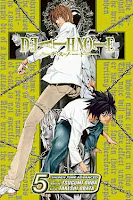 Author: Tsugumi Ohba
Author: Tsugumi Ohba
Illustrator: Takeshi Obata
U.S. publisher: Viz Media
ISBN: 9781421506265
Released: May 2006
Original run: 2003-2006 (Weekly Shōnen Jump)
I’ve only recently really been getting into manga but have definitely been enjoying my foray into the genre. Death Note has consistently been among the best series I’ve found so far. The first four volumes were fantastic and I was looking forward to reading the fifth, Whiteout. Although still very good, ultimately I wasn’t taken by it as much as I was by the previous books. But I’m not going to let that stop me from reading the rest.
At the end of the fifth installment, Love, Light had turned himself in to the investigation team for observation in an attempt to convince L that he wasn’t Kira. Whiteout begins with both Light and Misa imprisoned under suspicion for being one of the Kiras, which leads to the voluntary imprisonment of Light’s father as well. Eventually, all three are released, but L still hasn’t been completely convinced of their innocence so Misa is put under constant surveillance and Light is literally chained to L. While he was under observation, Light secretly gave up ownership of the Death Note (although I suspect only temporarily), resulting in the loss of all of his memories directly relating to it. Since he is still assisting with the Kira investigation, this puts him in an awkward position. He is now unknowingly trying to outwit himself while insisting upon his innocence, sometimes despite the evidence and occasionally even hiding it. And on top of that, the investigation is only going to get more complicated when the existence of a third Kira is discovered.
The pacing in Whiteout has definitely slowed from that of the previous books. However, there are still some absolutely fantastic and exciting scenes. Additionally, a little more humor is introduced into the story, though it still has a predominantly serious tone. Whiteout continues to develop and introduce human characters, but we hardly get to see the Shinigami at all. I expect the volume mostly serves as a transition between the feel of the first four volumes and what’s to come; while the still very interesting, it almost feels like a placeholder.
The art in Whiteout remains excellent. What especially stood out to me in this volume is how the character’s appearances change after they have been held in solitary for so long. In particular, the change in Light is subtle but extraordinarily effective in portraying his personality shift. I’m continue to be impressed by the artist’s skill. The Shinigami, which have always been the most interesting visually, don’t really make much of an appearance in Whiteout. Unfortunately, even Rem and Ryuk only show up briefly in a few panels.
Whiteout was the first volume of the series that I don’t feel improved over those that came before. (Don’t get me wrong—it wasn’t a bad book by any means.) I missed the intensity between Light and L as they each tried to outwit and out-think the other. While Light’s ploy was brilliant in throwing the investigation off, it results in a significant decrease in tension plot-wise. Which is not so say Light and L being chained together isn’t’ amusing and that there aren’t other interesting and intriguing developments—because there are quite a few. I’m certain that Light’s plan hasn’t completely unfolded yet, and look forward to seeing what happens. I still have great confidence in Death Note and have already picked up the sixth book, Give-and-Take.

Speak Your Mind